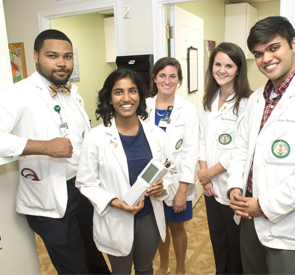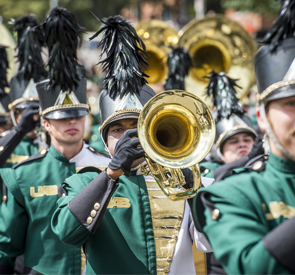-

Dr. John Jones III UAB Student Affairs co-creates impactful learning experiences, minimizes barriers, fosters a caring community, promotes sustainable environments while developing engaged leaders. We cannot accomplish this without the talented Student Affairs professionals who utilize their expertise every day to work toward our common mission. I am proud and appreciative of our collaborations with campus partners who share the vision of working to exemplify the tenets of the University of Alabama at Birmingham Forging Ahead Strategic Plan and the University of Alabama system. It takes the entire UAB community to move the needle and I am thankful to be a part of a community that is student-centered – UAB student Blazer centered.
As we embark on the next five years of our new strategic plan, Forward Together in Community, we know that our “living strategic plan” will create transformational experiences for our students and our campus community. The mutually constructed plan, created with insights from students, colleagues, and stakeholders throughout UAB, Birmingham, the UA system, and benchmarked against nationally recognized effective practices will become our guide for the future.
I am proud to share with you our new vision, mission, values, and priorities that will move the Division of Student Affairs forward. I look forward to our continued and new collaborations that innovate the student experience and impactful engagements at UAB!
Go Blazers!Sincerely,

John R. Jones, III
Vice President
UAB Student Affairs -
The University of Alabama at Birmingham (UAB) is a comprehensive public university located in downtown Birmingham, Alabama, the state’s largest city. UAB is part of the University of Alabama System, alongside the University of Alabama (UA) in Tuscaloosa and the University of Alabama in Huntsville (UAH). UAB was established as a separate campus of the system in 1966.
 UAB is recognized for its excellence in education, healthcare, and research. It is a globally impactful university with over $717 million in annual research expenditures, positioning it as a leader in cutting-edge research. The institution also ranks among the top 5% of all public U.S. universities in terms of research funding, and in the top 6% among all U.S. universities. UAB is ranked 6th in clinical trials expenditures among public institutions. The Harbert Institute for Innovation and Entrepreneurship (HIIE) has recorded eight straight years with a positive bottom line (among the top 20% nationally). All six UAB health-related schools are in the top 20 among public universities with NIH funding (#2 Health Professions, #4 Nursing, #5 Optometry, #12 Medicine, #15 Dentistry, #19 Public Health). UAB is committed to continued growth and innovation, aiming to expand its influence as a premier academic medical center and research institution.
UAB is recognized for its excellence in education, healthcare, and research. It is a globally impactful university with over $717 million in annual research expenditures, positioning it as a leader in cutting-edge research. The institution also ranks among the top 5% of all public U.S. universities in terms of research funding, and in the top 6% among all U.S. universities. UAB is ranked 6th in clinical trials expenditures among public institutions. The Harbert Institute for Innovation and Entrepreneurship (HIIE) has recorded eight straight years with a positive bottom line (among the top 20% nationally). All six UAB health-related schools are in the top 20 among public universities with NIH funding (#2 Health Professions, #4 Nursing, #5 Optometry, #12 Medicine, #15 Dentistry, #19 Public Health). UAB is committed to continued growth and innovation, aiming to expand its influence as a premier academic medical center and research institution.
As a center of learning, UAB offers a variety of academic programs, including 59 baccalaureate programs, 72 master’s programs, 43 doctoral programs, and multiple professional degrees. These programs span across the College of Arts & Sciences and 10 schools, including Business, Dentistry, Education, Engineering, Health Professions, Graduate School, Medicine, Nursing, Optometry, and Public Health.
In addition to its traditional degree programs, UAB is known for its innovation in education. Majors and research opportunities in fields such as immunology, digital forensics, genetics, bioinformatics, cancer biology, and public health are available to both undergraduate and graduate students. The UAB Honors College provides more than 2,000 high-ability undergraduates with advanced research and learning opportunities, including the prestigious Science and Technology Honors Program.
UAB is home to one of the leading academic medical centers in the country. UAB Hospital is the third-largest public hospital in the U.S. and continues to expand its services to meet the needs of a growing patient population.
In fall 2023, UAB had a total enrollment of 21,160 students, highlighting UAB’s appeal to top students from Alabama, across the nation, and nearly 40 countries. As the largest single employer in Alabama, UAB has a significant impact on both the local and state economy. It generates an annual economic impact of $12.1 billion, providing essential services to the Birmingham business and professional communities. UAB also plays a key role in advancing technological innovation, economic development, and public health in the state and beyond.
20,905
STUDENTS
ENROLLED
AT UABRETENTION
82.4%
First-year retention (fall)
IMPACT
$12.1B
UAB community impact
-
-

Guiding Principles
The University of Alabama at Birmingham
Vision
UAB is a world-class research university and academic health system committed to understanding and improving the human experience.
Mission
UAB enriches society and improves health and well-being through transformational educational experiences, groundbreaking research, innovation and entrepreneurship, community engagement, and world-class patient care while serving our UAB, local and global communities.
Shared Values
We CARE
Collaborate: Work as a team for the greater good.
Act with integrity: Be accountable and always do the right thing.
Respect all: Champion diversity and opportunities for all, with civility.
Excel: Innovate and strive for excellence in everything we do.
At our core, we are here to make people’s lives better, and that starts right here at UAB with our own students, faculty and staff. We are committed to supporting their success and empowering them to make a positive difference in our local and global communities.
FINANCIAL SUSTAINABILITY
Strategic Goal: Increase giving from alumni and supporters and ensure that all resources available to UAB are used and managed effectively.
- Strategic Objective 1: Increase fiscal year giving.
- Strategic Objective 2: Increase alumni giving.
- Strategic Objective 3: Promote financial stewardship and increase spendable cash and investments to operations.
- Strategic Objective 4: Maintain or enhance the credit rating for UAB.
DIVERSITY
Strategic Goal: Support a campus community that values wide-ranging experiences and perspectives.
- Strategic Objective 1: Strengthen pathways to institutional access and educational success for all students.
- Strategic Objective 2: Nurture an educational climate that embraces wide-ranging perspectives.
- Strategic Objective 3: Engage in research, scholarship and creative activities that explore the impact of wide-ranging perspectives and life experiences that improve the quality of life for all people across diverse populations.
- Strategic Objective 4: Enhance excellence and connection to wide-ranging perspectives and life experiences through community engagement.
- Strategic Objective 5: Deliver excellence to a divers patient base.
ENVIRONMENTAL STEWARDSHIP
Strategic Goal: Educate the UAB community on environmental stewardship and sustainability, and encourage sustainable practices.
- Strategic Objective 1: Promote environmental stewardship/sustainability-related learning outcomes in applicable courses and majors.
- Strategic Objective 2: Support interdisciplinary and interprofessional research, scholarship and creative activities related to environmental stewardship/sustainability and encourage sustainable research practices.
- Strategic Objective 3: Engage the community in environmental stewardship/sustainability education and programs.
- Strategic Objective 4: Design, construct and maintain buildings to provide a safe and healthy indoor environment for students, faculty, staff and patients while mitigating the building’s impact on the outdoor environment.
-

Guiding Principles
The University of Alabama
Mission
The University of Alabama System, an institution of higher education created for learning, exists to improve the lives of everyone we affect through the teaching, research and service rendered by our component campuses and health system.
Values
- Integrity
- Leadership
- Accountability
- Respect
Vision
We will be the preeminent public system of higher education and health care in the United States.
Core Principles
- Assure that everything we do is for the purpose of improving the lives and health of the citizens of the State of Alabama.
- Make higher education accessible and diverse,prepare our students for success, and meet the workforce needs of the State.
- Be accountable for every dollar we receive while maintaining the highest standards of excellence in every program and endeavor.
- Work to lead a unified approach to improving education at every level in Alabama.
- Work to help lead a unified approach to improving the economy, opportunities, and comprehensive health care for all citizens of Alabama.
- Elevate the status, stature and influence of the University of Alabama System so that we can call on all people devoted to the University of Alabama,UAB, UAH, and the UAB Health System to unite for common purposes.





